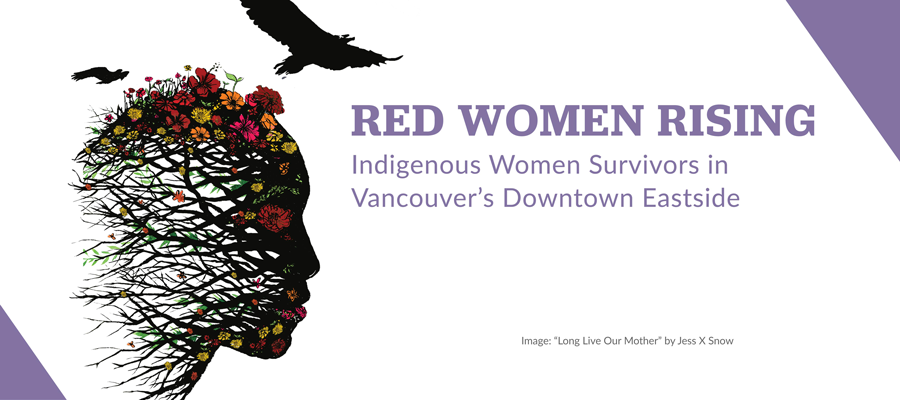What BC’s energy industry has to do with violence against Indigenous women

The following post was adapted from the executive summary of Out of sight, out of mind: Gender, indigenous rights, and energy development in British Columbia, Canada.
“It’s not a pity story. We’re not looking for sympathy. But the public has to recognize that this is a disaster in the making.”
—Norma Pyle, Blueberry River First Nations
Intensive energy development in the Peace River region in northeast British Columbia is a microcosm of the Canadian resource economy. Oil and gas extraction, coal mining and hydroelectric development help fuel the provincial economy and create high paying jobs that attract workers from across the country. In actively promoting intensive development in the northeast, federal and provincial officials have emphasized these benefits, while largely ignoring serious—and sometimes deadly—unintended consequences for wellness and safety that disproportionately impact the lives of the Indigenous peoples who live there, particularly Indigenous women and girls.
Government statistics show that Indigenous women and girls across Canada face much higher rates of violence than all other women and girls. Accounts from women and frontline service providers in northeast BC suggest that, if anything, the threats to the safety of Indigenous women and girls are even more acute in this region. For many Indigenous women and girls in the northeast, domestic violence, violence in the workplace and violence at the hands of social acquaintances and strangers is so pervasive it has become normalized. Amnesty International believes that failure to adequately address the unintended social impacts of resource development contributes to the risks faced by Indigenous women and girls.
For many Indigenous women and girls in the northeast, domestic violence, violence in the workplace and violence at the hands of social acquaintances and strangers is so pervasive it has become normalized.
The economic insecurity experienced by many in the northeast is a concern in its own right. In addition, economic insecurity is associated with increased risk of violence against women. The presence of a very large, young, mostly male transient workforce adds to this risk because young men are statistically more likely to be perpetrators of violent crime. These concerns are further compounded by patterns of drug and alcohol abuse among some resource industry workers which can fuel violence. Misogyny and racist attitudes toward Indigenous peoples, largely unaddressed in public life, have also made Indigenous women and girls more likely to be targets of violence.
Indigenous women and girls in northeast BC do not have access to adequate government supports and services to reduce the risk of violence. Frontline service providers supporting marginalized individuals, such as women’s shelters and food banks, describe a situation of constant crisis as needs outpace their capacity to respond. Amnesty International has also found law enforcement resources in the northeast, including the numbers of officers, officer training and orientation to be inadequate to meet urgent community needs.
A unique arrangement with the provincial government transfers additional funds to municipalities in northeast BC to offset the burden of hosting the resource industry, including the strain placed on social services and infrastructure by the many workers who temporarily migrate to the region for employment in the resource sector. However, no comprehensive and systematic assessment of the social service and infrastructure needs of communities in northeast BC has been conducted. There is also no accurate assessment of the actual size of the “shadow population” of temporary workers being served.
Traditions of hunting, fishing and gathering berries and plant medicines are central to the cultural identity of the Dane-Zaa, Cree, Métis, and other Indigenous peoples in the northeast, and are indispensable to the health and well-being of their communities. Indigenous elders and social workers describe the land as a source of individual and collective healing. The scale of resource development in the northeast has meant that Indigenous peoples—whose traditional territories are at the heart of the energy economy—now have very little land left that has not been directly impacted by some form of industrial development.
Indigenous peoples bear a particular and harsh burden from resource development on their lands, including the dramatic loss of access to their traditional territories and the rapid transformation of their economies.
While Indigenous peoples have been able to negotiate access to specific benefits from resource development, including contracts for community-owned businesses, a much greater share of the benefits goes to non-Indigenous people or flows out of the region entirely. At the same time, Indigenous peoples bear a particular and harsh burden from resource development on their lands, including the dramatic loss of access to their traditional territories and the rapid transformation of their economies. This contributes to further social strain on communities already severely harmed by largely unaddressed discriminatory government policies of the past.
Although Indigenous leaders and activists, local officials, academic researchers and the province’s own health ministry have long raised concerns about the potential negative social impacts of resource development in northeast BC, these concerns have had little influence on the decision-making processes around resource development. Although Indigenous peoples are increasingly able to negotiate benefit agreements around projects approved by government, it is unlikely their voices will be heard if they believe a project should not proceed or should be substantially altered. Governments have denied that there is any requirement for Indigenous consent to resource development projects despite domestic legal precedents indicating otherwise and the obligations under international law.
Decisions are made on a project-by-project basis with inadequate attention to the long-term cumulative social impacts, including the specific impacts on Indigenous women and girls. Land rights of Indigenous peoples protected in historic treaties and enshrined in the Canadian Constitution are not formally incorporated into the approvals process. Moreover, analysis of the distinct impacts of initiatives on people of all genders, in particular women and girls—which is a requirement for projects involving Canadian government-supported overseas development assistance—is almost never part of the decision-making process domestically and has never been part of the decision-making process for projects in northeast BC.
In decisions potentially affecting the rights of Indigenous peoples, governments in Canada need to take account of the lasting harm created by such wrongs as the denial of their land rights and efforts to forcefully assimilate Indigenous societies.
Canada has committed to uphold international human rights standards that require all levels of government to take every reasonable measure to ensure that the rights to health, livelihood, culture, and the right to live free from violence and discrimination are respected, protected and fulfilled. These obligations impose a duty on all levels of government to take rigorous precautions to ensure that their decisions and actions reduce, rather than increase, the risk of harm and resulting human rights violations. In particular, all levels of government must refrain from taking actions that deprive people of their human rights, to ensure that individuals and corporations do not violate human rights, and to take positive action to foster the enjoyment of human rights by all. The requirement of ‘due diligence’—the responsibility to take every reasonable precaution to prevent human rights violations—is even greater when past government actions have already harmed groups or individuals or put them in situations of heightened risk of further human rights violations.
In decisions potentially affecting the rights of Indigenous peoples, governments in Canada need to take account of the lasting harm created by such wrongs as the denial of their land rights and efforts to forcefully assimilate Indigenous societies. Particular attention must be paid to the fact that Indigenous women and girls in Canada face much higher rates of violence than other women and girls.
Amnesty International is calling on the federal and provincial governments to work with Indigenous peoples organizations and frontline service providers to uphold these crucial human rights safeguards in northeast BC.
—
Read the full report and recommendations at amnesty.ca/outofsight.
Topics: Environment, resources & sustainability, First Nations & Indigenous, Racism & racial justice, Women



